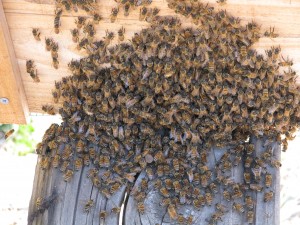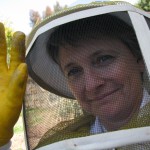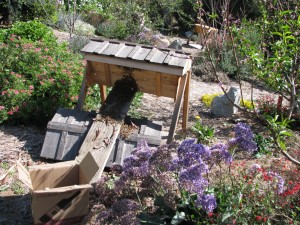Catching My First Bee Swarm
 Today was warm but very windy, and I was stealing some time to work on trellises I’m building for the passionflower vines (another story for another time, and definitely for the humor section). The area I was working in was close to my house. Inside an enclosure for my trashcans there stands a stack of nine extra bee supers (or boxes). Last year a swarm moved in and I’ve let them stay since they were so happy (and had so much room!). I have a hive and two empty Top Bar hives down in my specially planted Bee Garden; why should a swarm go there when it can be near trashcans? So today I’m out there trying to unroll a roll of cattle wire without losing a finger, and I hear a loud buzzing. I looked up to see bees flying in ever widening circles around the trashcan enclosure. Normally they are in and out in a straight line (a honey flow) when gathering pollen. I wondered if they were being attacked or bothered by something because in my mind it is still early in the year. Then I remembered it is March already! The hive was swarming.
Today was warm but very windy, and I was stealing some time to work on trellises I’m building for the passionflower vines (another story for another time, and definitely for the humor section). The area I was working in was close to my house. Inside an enclosure for my trashcans there stands a stack of nine extra bee supers (or boxes). Last year a swarm moved in and I’ve let them stay since they were so happy (and had so much room!). I have a hive and two empty Top Bar hives down in my specially planted Bee Garden; why should a swarm go there when it can be near trashcans? So today I’m out there trying to unroll a roll of cattle wire without losing a finger, and I hear a loud buzzing. I looked up to see bees flying in ever widening circles around the trashcan enclosure. Normally they are in and out in a straight line (a honey flow) when gathering pollen. I wondered if they were being attacked or bothered by something because in my mind it is still early in the year. Then I remembered it is March already! The hive was swarming.

Just before a new queen hatches, the old queen takes a group of bees (depending upon the size of the hive, it could be 20,000 bees) to go find a new home. First they exit the hive and find a place to rest and reconnoiter. This is when people see them hanging from trees, underhangs, trashcans, whatever. Scouts are sent out to find a good place to stay. Sometimes they will stay where they are, even if it isn’t a good idea, such as the underside of a palm frond which a swarm built comb on for a short time some years ago in my yard. This swarm mercifully gathered in a guaje tree just opposite the enclosure.

I let the wire go and realized how unprepared I was. I hadn’t completely finished preparing the bars for the top bar hives (so much to do!). My daughter and I have kept a hive for years. I really wanted that swarm, and although I’ve read about it and watched YouTube videos about it, just haven’t captured a wild swarm myself. I decided to try and get them.
First, I ran inside and rewatched a YouTube vlog on capturing a swarm, just to refresh my memory and boost my confidence. Then I ran down to the bee garden and prepared a top bar hive. I moved it to a better location, poured oil in the cups it sits in to keep out ants, and then finished preparing the bars. I’d serendipitously purchased craft sticks just yesterday ( a special stop at JoAnns), and I rubbed old wax into the grooves to make the craft sticks stick. Top bar hives have no foundation like Langstroth hives. The bees are encouraged to build their own comb, using the bit of craft stick hanging down from the bars as a guide. This is a healthier way to for bees to live when captured. Then I dropped a few drops of lemongrass oil into the hive; bees really like it and are attracted to it. I also smeared a little organic honey inside for some instant food. This sounds so smoothly done, but actually there were a dozen trips between the bee garden at the bottom of the property, the house, the shed and the swarm, all done in a crazed, frantic and nervous sort of way. A mad woman. Again I’m grateful for good neighbors.

I suited up in full bee gear. Many people catch swarms without protective gear, or with just a veil. When bees swarm they are the least likely to attack because they aren’t defending a hive. They are clustering around their queen, not wanting to be separated from her. However, since I now swell up dramatically when stung, I decided to take no chances.

Fortunately the bees weren’t high up. I dragged out a stepladder and found a smallish cardboard box.

Standing on the ladder and shoving the box under the swarm, I shook the branch, knocking the bees into the box. When I thought I had most of them, I carried the box, full of crawling bees, down to the hive. I wish I could have taken a photo, but with the thousands of bees in the box I didn’t want to go get the camera and fumble with it with my gloves; I didn’t want to hurt any of the girls and they needed to be relocated before they took flight. I shook the box into the open top of the hive, and then put the top bar lid on. There were still bees back on the tree. I didn’t see the queen, and I really needed to make sure I got her. I shook in the rest of the bees and then carried them back down to the bee garden.

I didn’t want to open the hive again, so I propped a board up to the entrance holes, then shook the box of bees out onto the ramp. Bees will climb, and climb they did. I used a bee brush to carefully collect bees that had clung to the outsides of the hive, and dumped them on the ramp, too. There was quite a traffic jam for awhile.

Eventually all the bees were in. I removed the ramp and cleaned up… not a sting. Actually, once I first climbed the stepladder I felt and heard the lack of anger in the swarm. They weren’t making a high-pitched angry buzzing noise. Tradition has it that you should talk to your bees; make sure to tell them about any change in the household. So I talked to them as I transported them down to what would hopefully be their new home. Just before dark I rapped once on the side of the hive and all 10- or 20-thousand of them hummed at me. If I got the queen and they are happy, then they will stay. Otherwise they’ll swarm again. No bees were harmed, and the few left up by the tree wondering where the old queen went were close enough to the old hive to go back, and make their allegiance to the new queen.


I came inside feeling good about gently relocating them, and had some dark chocolate to settle my nerves! Then I went on to wrangle with the wire and the trellises, which was far more trouble than moving a swarm of bees.
